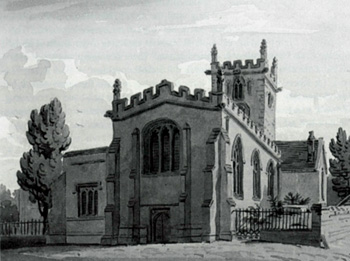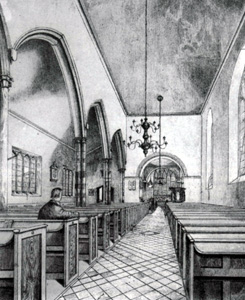Saint Marys Rectors

Saint Marys in 1912
Advowson
The advowson of Bedford, Saint Mary was claimed by the Bishop of Lincoln and the Prior of Dunstable in 1200. The bishop produced charters of William I (1066 to 1087), Henry I (1100 to 1135) and Henry II (1154 to 1189). At that time Bedfordshire fell in the Diocese of Lincoln. The priory produced charters of Henry I and Henry II. The dispute was mediated by the bishop retaining the advowson whilst giving a 20 shilling pension to the priory arising from the church. This sum was given up by the priory in 1334. The bishop kept the advowson afterwards and, by 1900 had two turns selecting the next incumbent to every one turn selecting him by Balliol College, Oxford.

The interior of Saint Mary's in 1912 looking east
Rectors
A list of Rectors of Saint Mary, as far as can be reconstructed, is as follows:
- 1200: Warinus;
- 1217: Alan;
- 1227: Robert de Saint Edmunds, chaplain;
- 1233: Thomas de Karleolo;
- 1237: Stephen de Cokehull, chaplain;
- Stephen de Touhen;
- 1259: Alan de Stocton, chaplain, on the death of Stephen de Touhen;
- 15th April 1272: William de Edelesborowe, subdeacon, on the resignation of Alan;
- 3rd January 1307: John de Chaworth, acolyte, on the death of William de Edelsborough;
- 10th July 1307: William de Southleverton, chaplain, on the resignation of John de Chaworth;
- 14th December 1313: Robert Maulouel, acolyte, on death of William;
- 13th November 1335: John de Bello Monte, priest;
- 30th July 1345: John Dauler of Brampton [Huntingdonshire], priest, on the resignation of John de Ulseby;
- 23rd December 1345: John de Creyk, Vicar of All Saints, Shepreth, Diocese of Ely by exchange with John de Brampton;
- 31st October 1348: John de Hampstede, Vicar of Saint Nicholas de Brightelmstone [Brighton], Chichester Diocese, by exchange with John de Crek;
- 6th February 1349: John de Multhorp, priest;
- 18th September 1357: John de Luda, priest, on the resignation of the last Rector, who exchanged to the Chantry at the Altar of Blessed Thomas the Martyr in Lincoln Cathedral;
- 15th January 1359: John Carter of Irthlingborough [Northamptonshire], priest, by exchange with John de Luda;
- 24th July 1359: William Cohull, priest, on the resignation of John Carter, exchanged for Gunnerby Rector;
- 4th January 1384: John Andrewe of Houghton Conquest, chaplain of the Chantry soul of Winschcombe, in Lincoln Cathedral;
- 9th January 1410: John Gore, chaplain, on the resignation of John Andrew;
- 18th July 1417: Simon Baumburgh, clerk, on the death of John Gore;
- 6th April 1433: Angerus Erle, priest;
- 6th October 1438: Thomas Uda, priest;
- 18th August 1444: William Krykby, priest, on the resignation of Thomas Uda;
- 23rd November 1444: John Veysyn, priest;
- Richard Sland, priest, buried 23 Oct 1543;
- 13th January 1558: Robert Lindford, priest, on resignation;
- 15th July 1561: Martin Adam;
- 14th January 1589: John Baines;
- 10th May 1591: John Chambers MA;
- 21st January 1629: Edward Lloyd;
- 16th March 1630: Giles Thorne, buried 24th June 1671, will dated 9th October 1669, proved 28th June 1671;
- 26th July 1671: William Jackson, on the death of Giles Thorne;
- 7th September 1675: Charles Stokes MA, on the resignation of William Jackson;
- 12th August 1681: Oliver Pashler MA on the death of Charles Stokes, ordained 24th September 1671;
- (31st May 1708: Andrew Moor: curate; ordained 30th May 1708);
- (1712: Francis Read, curate);
- 10th March 1724: Thomas Gery , on the death of Oliver Pashler;
- 22nd September 1727: William Smith on the resignation of Thomas Gery;
- 24th January 1734: William Smith, on the resignation of William Smith;
- 22nd December 1746: James Wilkinson, ordained as priest 21st December 1746;
- 17th January 1749: Charles Jackson;
- 18th May 1761: Thomas Birt, clerk, on the resignation of Charles Jackson;
- 5th August 1779: Benjamin Beresford, clerk, on the death of Thomas Birt;
- 13th November 1790: Charles Abbot; licensed with 30 guineas stipend and surplice fees;
- 31st December 1819: William Collins Cumming, on the death of Benjamin Beresford;
- 24 March 1825: Theodore Bouwens, on the death of William Collins Cumming;
- (1851: C. Brereton, curate);
- 3rd April 1869: Charles Brereton, on the death of Theodore Bouwens;
- 1896: George Henry Pratt;
- 1911: George Gibson Brown;
- 1935: Horace Fort, an American;
- 1945: Donald Bertram Harris;
- 1959: Stephen Howard Adams;
- 1967: Peter Hill
- 1970: Christopher Kingston Hamek Cooke.
The parish was abolished in 1975 and absorbed into Bedford, Saint Paul, the church duly closing.

Saint Mary's by Thomas Fisher about 1815
Episcopal Visitations
Volume 81 published by the Bedfordshire Historical Records Society (2002) is devoted to returns made during episcopal visitations to the county by the Bishop of Lincoln in the early 18th century, edited by former County Archivist Patricia Bell. It throws some interesting light on the general state of the church in the parish.
In 1706 Oliver Pashler, the rector, noted that the parish: "runs about a measured mile Southward, and halfe a mile Westward. There are at least 112 families in it. There are among these no Papists, or reputed Papists, but 21 families of Dissenters, which are Presbyterians, Independents and Anabaptists mixed. They all go to one place of worship. There is no Meeting-house within the parish…Persons of chiefest note that live in it are Bell and Spencer Esquires, Mr. Hawes and Mr. Syndry, who all have seats or houses of their own in it, and good estates in, and out, of the Parish. The Monuments of the Church are common, and of no great standing. Nor is there any thing remarkable in the parish except Caldwell House which stands at the West end of it, and was formerly a religious house, from which 'tis said there went a vault quite under ground to the Friers in St. Paul's parish".
In the return of 1709 Pashler recorded that the previous year he had been given a curate, Andrew Moor, who also acted as curate at Biddenham. He stated that there were 465 people in the parish, of whom 102 were Independents. Several of his congregation were not confirmed but none were unbaptized. The previous Easter there had been forty or so communicants "some, though come to years, yet seldom or never receive" however. The parish had gone up-market a bit since 1706, though: "Lady Anne Wingate, with her family, is come into this parish, since my last Visitation".
Three years later, in 1712, Francis Read was curate and, interestingly, Pashler revealed that he lived in Buckingham, though the curate resided in the parish. This was quite a common state of affairs at the time. Rectors or vicars were frequently non-resident and relied on sub-contracting out their religious and pastoral duties to curates who, of course, received a far smaller income from the living than did the absentee incumbent. Such actions tended to get the Church of England a bad name and such curates were often characterised as ignorant and lazy though it would take considerable research to establish whether this was often the case or whether it was a misperception, perhaps encouraged by those wishing to spread nonconformity or to reform the church itself. Pashler's curate had an allowance of £25 per annum and evidence of the returns is that he was probably very assiduous as he seems to have conducted a good number of services and to have built up the parish. In 1712 he was recorded as conducting two services each Sunday. He administered communion four times a year and, out of 258 communicants 50 had received the previous Easter.
The return of 1717 shows that nonconformist dissent in the parish had not grown, there were now 100 as opposed to 102 in 1709, again suggesting that curate Francis Read was doing a reasonable job. He noted in the return: "My Rector does not reside in the Parsonage House, being excused his Residence in his Vicarage House at Buckingham". Read's allowance had now risen to £26 a year; he did not live in the parsonage. He reported: "I know of None coming to Church that are Unbaptized. Some indeed wait for Confirmation. I Baptiz'd on August 11th 1717 two Adults, Elizabeth Barrat and Elizabeth Hipwel, two Young Maidens one about 12, the other about 15 Years of Age. Publick Service is read twice every Sunday, on Wednesdays, Fridays, and all Holy-days, as the canons direct and Acts of Uniformity requires on that Account". He still administered communion four times a year to the congregation of 250 and about 80 received the previous Easter, quite a substantial rise from the 50 of 1712.
Read was still curate in 1720 and he noted that he resided "not in the Parsonage House, but near it, and the cause of my Non-residence is because 'tis Inhabited by a Tenant". In other words Rev. Pashler was renting out the parsonage to swell his income. Read still earned £26 a year and still conducted two services on a Sunday and one every Wednesday and Friday "in the morning". By now seventy or eighty people usually received communion at each of the four times a year it was administered, with eighty receiving the previous Easter.

Saint Mary's interior looking east by John Sunman Austin in 1851 [ref: X56/34]
1851 Ecclesiastical Census
On Sunday 30th March 1851 a census of all churches, chapels and preaching-houses of every denomination was undertaken in England and Wales. The local results were published by Bedfordshire Historical Records Society in 1975 as Volume 54, edited by D. W. Bushby. The return for Bedford, Saint Mary showed a church which could accommodate five hundred, the general congregation on a Sunday morning being 230 and 460 in the afternoon with an additional 96 children at each service. The curate, C. Brereton (the rector, now Theodore Bouwens, was obviously still non-resident) noted: "The sittings in the Church are all open but are generally appropriated to the most constant attendants on the understanding that if they are absent others may occupy their seats. The Church holds 500 comfortably but sometimes upwards of 550 are accommodated".